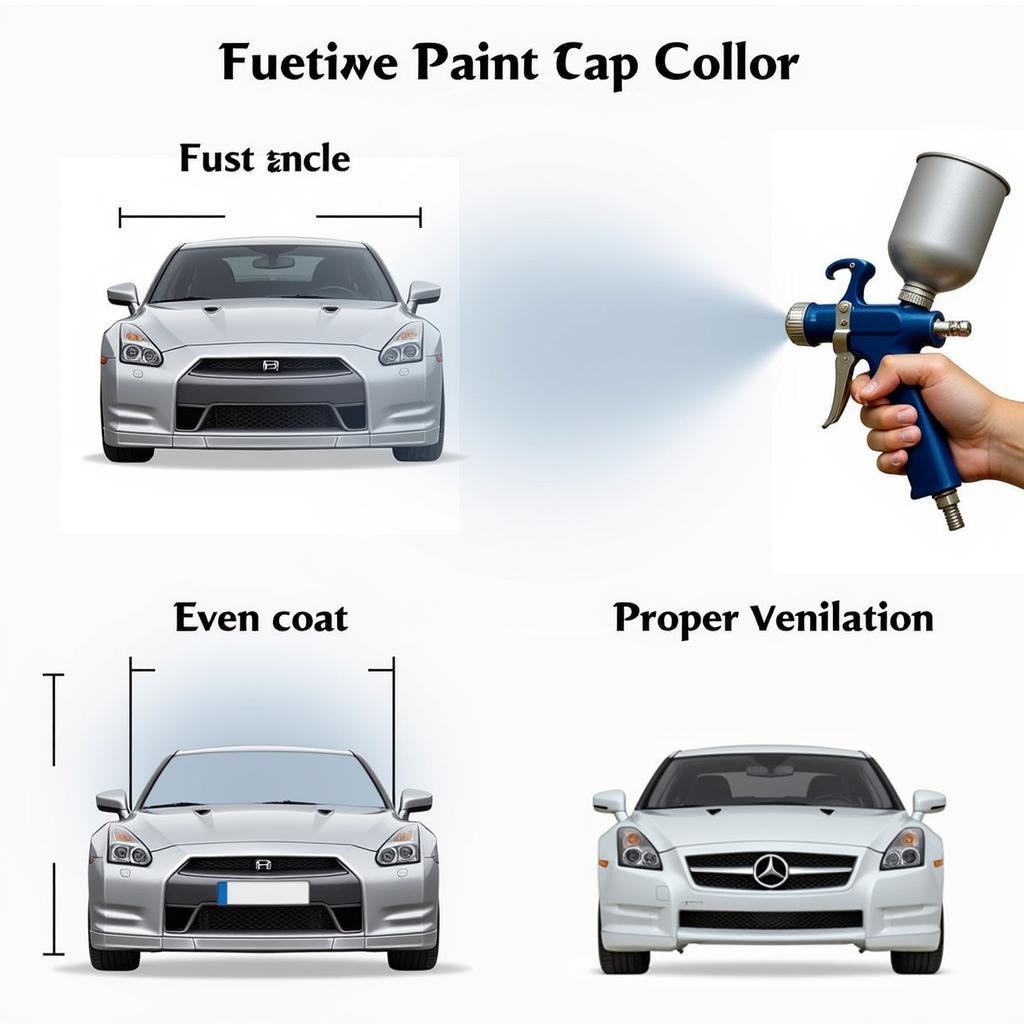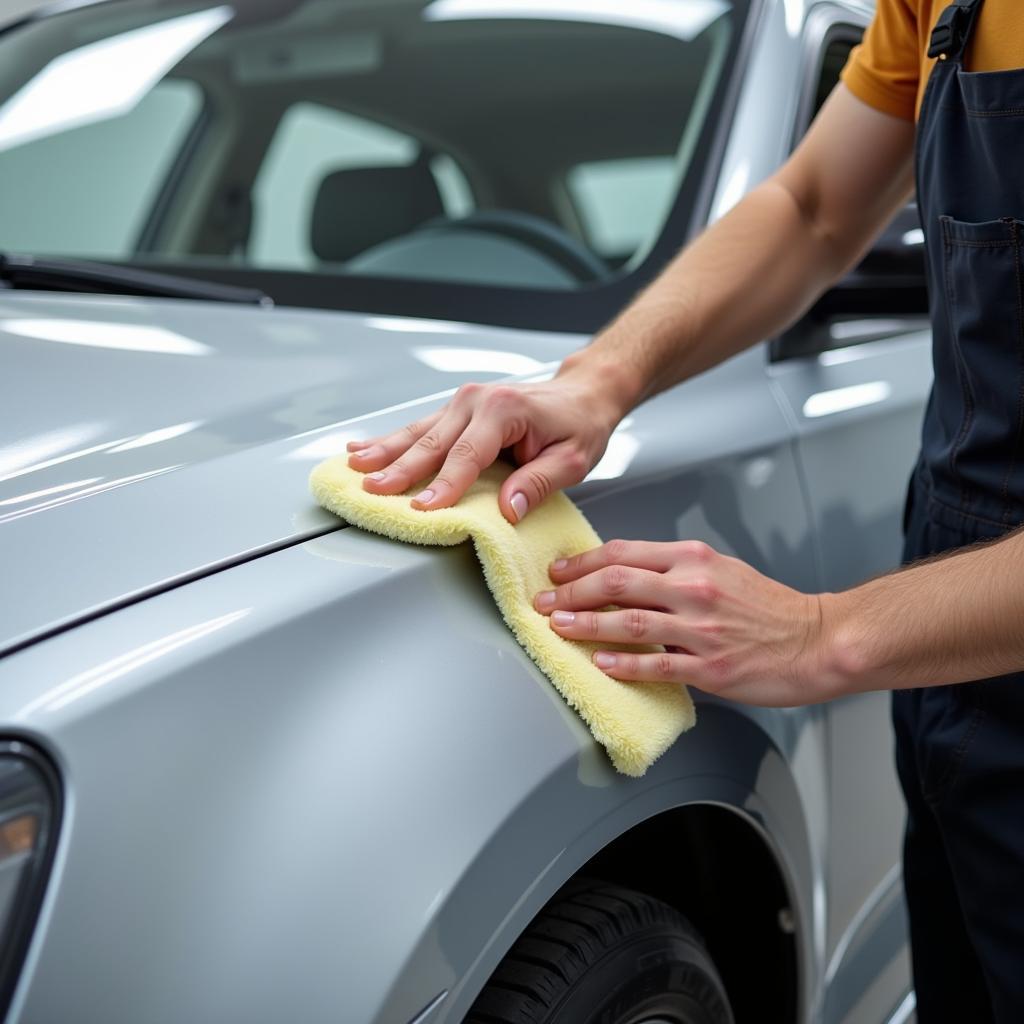
Applying Car Paint with a Spray Gun
Getting your car painted can be a significant investment, so understanding the process and knowing how to achieve the best results is crucial. This guide provides expert Painting Car Tips Repair advice, covering everything from preparing your car to selecting the right paint and ensuring a flawless finish. We’ll delve into the nuances of car painting, offering valuable insights for both DIY enthusiasts and those looking to hire professionals.
Choosing the right paint for your car repair is paramount. Consider factors like durability, color matching, and finish type. Do you want a glossy, matte, or satin finish? High-quality automotive paint is essential for long-lasting results and protection against the elements. If you’re unsure about which paint to choose, consult with a professional car paint repair service like those found in car paint repair lehigh valley. They can offer tailored advice based on your car’s make, model, and your specific needs.
Preparing Your Car for Painting
Proper preparation is the key to a professional-looking paint job. This involves thoroughly cleaning the car, removing any rust or imperfections, and sanding the surface to create a smooth base for the paint to adhere to.
Cleaning and Degreasing
Start by washing the car with a high-quality car wash soap and water. Pay close attention to removing dirt, grime, and any wax or sealant residue. Then, use a degreaser to remove any remaining oils or contaminants. A clean surface is crucial for proper paint adhesion.
Rust and Imperfection Removal
If there’s any rust present, it needs to be removed completely. You can use a wire brush, sandpaper, or a chemical rust remover. Once the rust is gone, apply a rust inhibitor to prevent it from returning. Any dents or scratches should be filled with body filler and sanded smooth.
Sanding
Sanding is essential for creating a smooth surface for the paint to adhere to. Start with a coarser grit sandpaper and gradually work your way up to a finer grit. This process ensures proper paint adhesion and a smooth, even finish.
Choosing the Right Paint and Tools
Selecting the right paint type and application tools can significantly impact the final outcome. From primers and base coats to clear coats and specialized equipment, understanding your options is essential.
Types of Automotive Paint
Several types of automotive paint are available, each with its pros and cons. These include acrylic lacquer, acrylic enamel, and urethane. Urethane paints are generally more durable and resistant to chipping and fading.
Application Tools
The right tools can make a significant difference in the quality of your paint job. Spray guns, paint rollers, and brushes are common tools used for car painting. Spray guns offer the smoothest finish, but require more skill and practice. If you are new to car repair and painting, refer to how to repair small chips in car painting for simpler repair techniques.
Primers and Clear Coats
Primers provide a base for the paint to adhere to and help to hide imperfections. Clear coats protect the paint from UV rays and environmental damage, adding depth and gloss to the finish. How to effectively use a primer is also discussed in communities, like on how to repair car paint rot reddit.
Applying the Paint
Applying the paint requires patience and attention to detail. Following the correct techniques, ensuring even coverage, and maintaining a controlled environment are crucial for a flawless finish.
Painting Techniques
Whether you’re using a spray gun, roller, or brush, apply the paint in thin, even coats. Allow each coat to dry completely before applying the next. This prevents runs and drips and ensures a smooth, even finish.
Ensuring Even Coverage
Overlap each stroke slightly to ensure even coverage. Avoid applying too much paint in one area, as this can lead to runs and drips.
Environmental Considerations
Paint in a well-ventilated area, free from dust and debris. The ideal temperature for painting is between 68°F and 80°F with low humidity.
 Applying Car Paint with a Spray Gun
Applying Car Paint with a Spray Gun
Finishing Touches
After the paint has dried, you may need to wet sand and polish the surface to achieve a perfectly smooth and glossy finish.
Wet Sanding and Polishing
Wet sanding removes any imperfections and creates a smooth surface for polishing. Polishing brings out the shine and depth of the paint.
Maintaining Your New Paint Job
Once your car is painted, proper maintenance is essential for preserving the finish. Wash your car regularly with a mild car wash soap and wax it every few months to protect the paint and maintain its shine. If you are looking for car repair and painting services around your area, try searching for car repair and paint near me.
 Final Polish of Car Paint
Final Polish of Car Paint
Conclusion
Painting your car can be a rewarding experience if done correctly. By following these painting car tips repair, you can achieve a professional-looking finish that will last for years. Remember, proper preparation, quality materials, and patience are key to success. If you’re unsure about any part of the process, consider consulting with a professional car paint repair service, especially if you are looking for international services like those available in car paint repair singapore.
“A quality paint job isn’t just about aesthetics,” says John Smith, Senior Automotive Technician at CarCare Experts. “It’s about protecting your car’s body from the elements and maintaining its value.” Properly applied paint acts as a barrier against rust and corrosion, extending the life of your vehicle.
“Don’t underestimate the importance of preparation,” adds Maria Garcia, Lead Painter at Custom Auto Finishes. “A thorough cleaning and proper sanding are crucial for achieving a flawless finish. Rushing through these steps will compromise the final result.”
Need help with your car’s paint repair? Contact us via WhatsApp: +1(641)206-8880 or Email: [email protected]. We offer 24/7 customer support.
